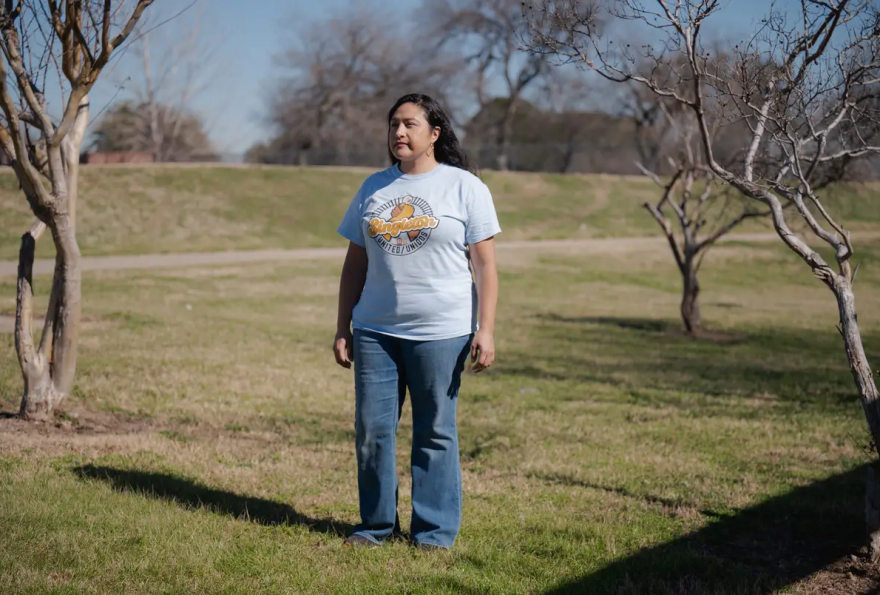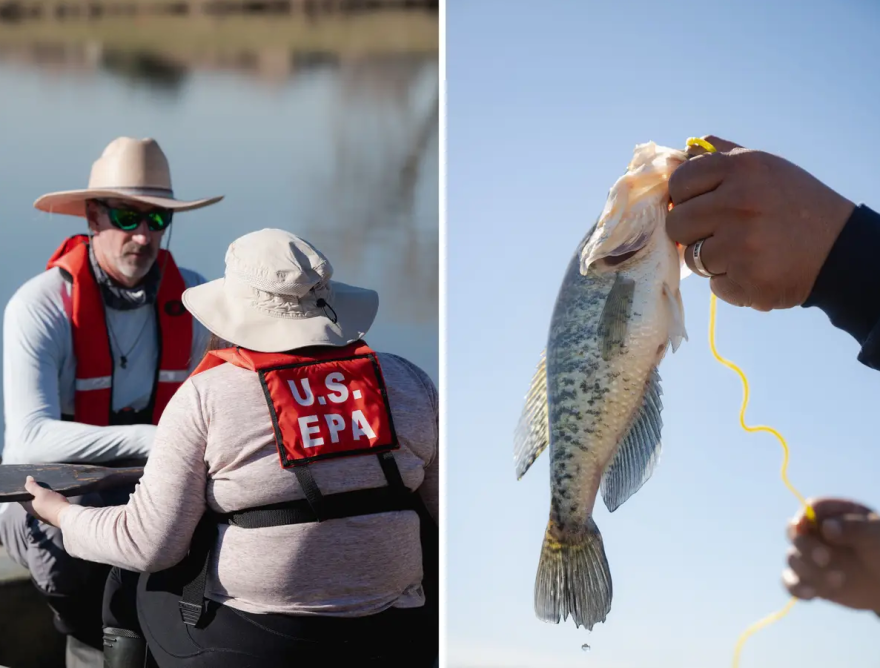Fish Trap Lake, five miles west of downtown Dallas, glowed with sunlight, ducks and geese swam, and a man with a fishing rod cast his line on a warm January morning. On the trail that loops around the 10-acre lake located inside a park, mothers with strollers walked to the sounds of rippling water and birds chirping.
Across the street from the park stands a row of industrial companies, including plants that turn sand, water and cement into concrete to build highways and subdivisions and high-rises in fast-growing Texas.
While fish is in the lake’s name, Janie Cisneros, 41, a mother and digital researcher who grew up nearby, says it’s common knowledge in the area to “catch them, don't eat them.” Locals believe the lake is polluted from wastewater runoff from the nearby plants.
Cisneros, the director of the neighborhood association Singleton United/Unidos, said many residents who live nearby have long complained about pollution from the plants, and suspect that it’s contributing to health problems ranging from asthma to bronchitis to throat cancer. They also say the thousands of concrete batch plants located across Texas disproportionately impact low-income communities like theirs.

West Dallas’ Zip Code 75212, where 27,000 people live, is 68% Hispanic and 25% Black. Cisneros, wearing her signature cherry lipstick and black neighborhood association shirt, said that for decades a relentless stench has infiltrated the homes of residents in her working-class neighborhood.
Residents have long complained to the state’s environmental agency about pollution from the plants and say their concerns have been brushed off. But now their efforts have caught the attention of the U.S. Environmental Protection Agency.
The agency has found that the air pollution and particulate matter from concrete batch plants can increase the risk of asthma and cardiac arrest if people inhale too much of it.
Now it has launched a pilot project — the first in Texas — that will survey air, water, and soil to determine how the combined pollution from this cluster of industrial sites impacts public health in two predominantly Black and brown Dallas neighborhoods: West Dallas and Joppa in South Dallas.
EPA says the project is expected to be completed by July 2024. The agency’s final report will be shared with the communities, the city of Dallas and the Texas Commission on Environmental Quality, the state agency that regulates batch plants.
But before any of that can happen, the first step was going fishing.
Fish will be tested for heavy metals
By 9:30 a.m. on Tuesday, three EPA scientists, wearing bright orange life vests, grabbed two Home Depot buckets, stuffing them with buoys and fish traps meant to capture predator fish like bass.
They boarded a small beige boat branded with the agency's logo. When the boat's motor refused to start, they paddled to the lake's center.
Using cat food as bait, they cast their nets.
“[These nets] are just a really effective way to try and catch a lot of fish in a short amount of time,” said Rob Cook, an environmental scientist who has worked for the EPA for 12 years.

Cook, a 54 year-old who wore rain boots, reflective sunglasses and a straw hat, said the group needs to catch three to five catfish and predator fish like bass, all similar in size, for a reliable testing sample.
Nicholas Scott, 30, an EPA scientist who was on the boat with Cook, says they will filet the fish, freeze the filets and send them to a lab to test the tissue for heavy metals like lead and arsenic. The results from water sampling and the fish tissue analysis will help the EPA determine whether the lake’s water or fish are harmful to human health.
They paddled back to shore, leaving four red buoys floating in the lake, marking their nets’ location. Then they picked up trash around the lake for a couple of hours before rowing back out to retrieve the nets.
Kirk McDonnell, a spokesperson for the Texas Parks and Wildlife Department — which stocks the lake with catfish, bass and other species — said in an email that because the lake is near industrial sites and sometimes receives flood water from the Trinity River, which is under a fish consumption advisory, the department’s Dallas-Fort Worth fisheries division has "speculated that fish contamination could be an issue with the fish currently in the lake.”
West Dallas resident Cynthia Medina, curious about the scientists' activities, stopped by the lake during her lunch break. The petite 30-year-old said she’s interested in the test results because her husband comes to the lake regularly to fish.
“I tell him: Don’t take [the fish] home, we are not going to eat it. It is not safe,” said Medina, who has lived in the neighborhood her entire life and works at a nonprofit that connects children of color to books and promotes reading.
She pointed to a shopping cart partially submerged near the lake shore. “I don’t know what those fish are eating.”
Scientist hopes study informs policy
Aimee Wilson, an EPA scientist and project manager in a navy striped blouse featuring an embroidered EPA logo she stitched herself, said the agency decided to conduct a cumulative impact assessment in Texas because TCEQ was proposing changes to the state’s concrete batch plant permits, which sets the air pollution standards companies must follow.
Those changes included lowering production limits, reducing dust coming from plants and setting minimum distance requirements from nearby communities, but did not take into account the cumulative pollution created by plants clustered close together, like those near Fish Trap Lake.
For years, environmental advocates have criticized the state for not taking into account the health impacts for people living near multiple concrete batch plants.
In 2021, Harris County attorney and Lone Star Legal Aid, a nonprofit law group, filed civil rights complaints with the EPA alleging that the TCEQ discriminated against people of color and those with limited English proficiency in the agency’s permitting process to build new concrete batch plants and renew permits for existing ones.
“There hasn't been a lot of studies on [cumulative impact],” said Wilson, who has worked for the EPA for 14 years. “So we want to see what's there because we don't know.”
While TCEQ announced its new requirements for concrete batch plants last week, before the EPA study was completed, Wilson hopes their work can help the agency develop better guidance and policies for how to consider cumulative impacts from industry in future permit decisions.
At noon, as the EPA scientists on the boat approached the lake shore, Cisneros, the neighborhood association director, waited with her two nephews and her mom to see what the EPA crew caught.
The group did not catch any of the fish they were looking for, but a local resident who caught a bass with a fishing rod donated it so the EPA can test its tissue.
Cisneros said the EPA’s attention to her community is a relief because at times she feels like her concerns are ignored by state regulators.
“The EPA is being brave,” Cisneros said earlier in the day while sitting with her 4-year-old daughter, Lila Rosa Bravero, under the park’s pavilion. “They are not fearing that this [project] might open up a can of worms.”
Disclosure: The Texas Parks And Wildlife Department has been a financial supporter of The Texas Tribune, a nonprofit, nonpartisan news organization that is funded in part by donations from members, foundations and corporate sponsors. Financial supporters play no role in the Tribune's journalism. Find a complete list of them here.
This article originally appeared in The Texas Tribune at https://www.texastribune.org/2024/02/02/epa-concrete-batch-plants-study-dallas/.

